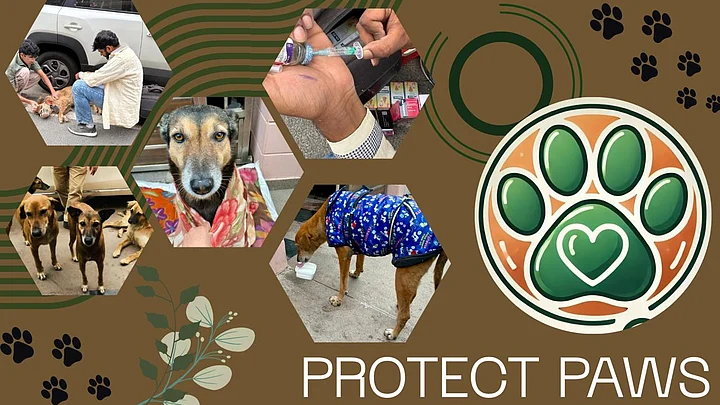Written by Kushal Sachdeva
The Stigma: A Fear that Fuels Cruelty
In Indian cities today, the sight of stray dogs triggers mixed reactions. While some people feed and care for them, others react with fear, disgust, or even hostility. Media stories of dog attacks, rabies, and aggressive packs have helped create a deeply rooted stigma against stray dogs, one that often paints them as dangerous, diseased, and uncontrollable.
As cities grow more crowded and urban lifestyles become busier, many people have little patience for sharing space with animals. For some, stray dogs symbolise a failure of governance or an inconvenience that interferes with a "modern, clean city." This frustration has led to extreme situations: legal petitions calling for mass culling, violent attacks on street dogs, and conflicts between animal lovers and Resident Welfare Associations (RWAs).
One striking example occurred in Noida, where residents drove cattle into a gated colony to protest against neighbours feeding stray dogs. This act reflects how emotional and divisive the issue has become.
But behind all this fear lies a simple truth: stray dogs are not the problem. Mismanagement of waste, urban expansion, and lack of proper sterilisation programs are the real causes behind rising stray dog populations. The dogs themselves are simply trying to survive in a world that has pushed them onto the streets.
The Truth: Street Dogs Play an Unexpected Role in Public Safety
Beyond simply existing in our cities, street dogs may contribute to making neighbourhoods safer. A study conducted by Ohio State University found that neighbourhoods with more dogs — both pets and strays — experience significantly lower rates of serious crimes like robbery, assault, and homicide. The dogs act as informal guardians, alerting residents to unusual activity and discouraging criminals who fear being noticed or disturbed.
In India, where many stray dogs recognise and defend their territories, they often alert residents to strangers entering a street late at night or unusual movements near homes. Several Indian animal welfare experts note that street dogs are naturally territorial and protective, characteristics that make them effective guardians of their communities. They bark at unfamiliar people, deter potential thieves, and maintain a presence that makes streets feel "watched."
Sadly, this protective role is rarely acknowledged in public discourse, overshadowed instead by negative stories that fuel public fear.
Stories of Compassion: How Communities Are Leading Change
Fortunately, many Indian neighbourhoods are already showing how coexistence can work beautifully.
In Delhi, colonies like Greater Kailash, Saket, and Vasant Kunj have come together to care for their community dogs. Families organise feeding schedules, build small shelters inside colony parks, and collectively fund vaccinations and sterilisation drives. Children grow up playing with these dogs, naming them, and seeing compassion modelled by their parents.
Organisations like Protect Paws NGO in Delhi have stepped in to assist these efforts, raising awareness, treating injured or sick animals, vaccinating them against rabies, and running sterilisation programs to humanely control the population.
In Bangalore, groups like The Voice of Stray Dogs (VOSD) operate on a larger scale, rescuing animals, providing long-term care, and conducting scientific sterilisation programs to prevent unchecked population growth. These efforts create not only safer lives for dogs but also healthier, more compassionate communities for people.
What Can You Do? Simple Acts of Kindness Matter
The good news is that you don’t need to adopt a dog to make a difference. Many families may not have the time, space, or parental permission to bring a dog home, but even without adoption, you can still help the street dogs around you live safer, healthier, and happier lives.
Put out bowls of water and food outside your house. Especially during summers and festival nights when fireworks can leave dogs stressed, access to food and water makes a huge difference.
Spend time with them — gently approach, speak softly, and slowly build trust. Over time, many street dogs recognise friendly faces and respond with loyalty and affection.
Help in sterilisation and vaccination drives (TNR: Trap-Neuter-Return) run by NGOs — many welcome volunteers and even young helpers who can assist with small tasks like spreading awareness, distributing flyers, or helping organise neighbourhood drives.
Raise funds or collect supplies — children can organise small donation drives in school or within their apartment complexes to gather blankets, food, or funds for treatment.
Create simple shelters with colony permission: even old cardboard boxes, umbrellas, or shaded spots during monsoons or extreme heat give stray dogs much-needed protection.
Educate neighbours and friends — spread awareness that sterilised, vaccinated dogs are healthier, calmer, and not a threat. Often, fears arise from misinformation.
Even small, daily actions can go a long way. For children, this is also an incredible way to learn responsibility, empathy, and kindness — lessons that stay with them for life.
Author Profile
Kushal Sachdeva is a writer and a passionate learner of emerging technologies, with a deep interest in computer science, innovation, and real-world problem-solving. An international-level robotics competitor, state-level hockey player, and founder of a Delhi-based NGO for stray dog welfare, he blends technical expertise, leadership, and social responsibility. His work explores how technologies such as artificial intelligence, blockchain, and digital public infrastructure can create more transparent, efficient, and inclusive systems across various sectors, including education, governance, healthcare, and mental health. Driven by a strong belief that technology, when applied thoughtfully, can bridge gaps and unlock opportunities for millions, his writing combines research, analysis, and personal insight to examine how innovation can address some of India’s most pressing challenges.
